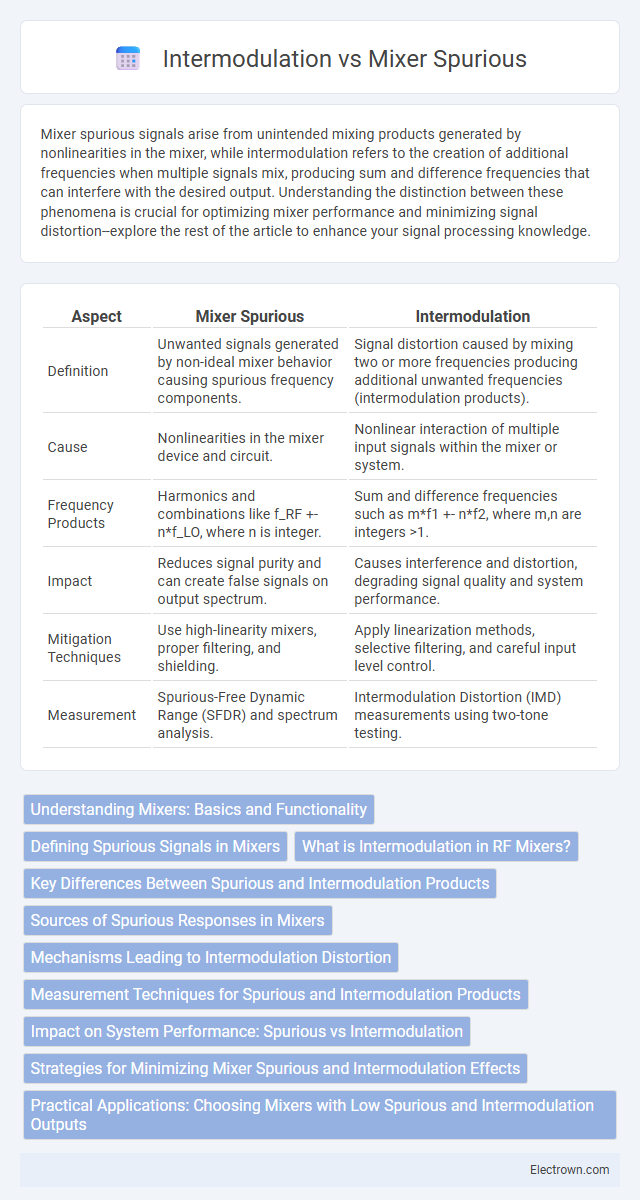Mixer spurious signals arise from unintended mixing products generated by nonlinearities in the mixer, while intermodulation refers to the creation of additional frequencies when multiple signals mix, producing sum and difference frequencies that can interfere with the desired output. Understanding the distinction between these phenomena is crucial for optimizing mixer performance and minimizing signal distortion--explore the rest of the article to enhance your signal processing knowledge.
Table of Comparison
| Aspect | Mixer Spurious | Intermodulation |
|---|---|---|
| Definition | Unwanted signals generated by non-ideal mixer behavior causing spurious frequency components. | Signal distortion caused by mixing two or more frequencies producing additional unwanted frequencies (intermodulation products). |
| Cause | Nonlinearities in the mixer device and circuit. | Nonlinear interaction of multiple input signals within the mixer or system. |
| Frequency Products | Harmonics and combinations like f_RF +- n*f_LO, where n is integer. | Sum and difference frequencies such as m*f1 +- n*f2, where m,n are integers >1. |
| Impact | Reduces signal purity and can create false signals on output spectrum. | Causes interference and distortion, degrading signal quality and system performance. |
| Mitigation Techniques | Use high-linearity mixers, proper filtering, and shielding. | Apply linearization methods, selective filtering, and careful input level control. |
| Measurement | Spurious-Free Dynamic Range (SFDR) and spectrum analysis. | Intermodulation Distortion (IMD) measurements using two-tone testing. |
Understanding Mixers: Basics and Functionality
Mixers are fundamental components in RF systems, performing frequency conversion by combining two input signals to produce new frequencies, including sum and difference frequencies known as intermodulation products. Spurious signals arise from nonlinearities within the mixer, generating unwanted frequencies that can degrade system performance by causing interference and reducing signal clarity. Understanding the balance between mixer linearity and conversion efficiency is crucial to minimizing spurious outputs and improving overall signal integrity in communication and radar applications.
Defining Spurious Signals in Mixers
Spurious signals in mixers refer to unwanted frequencies generated during the frequency conversion process, arising from nonlinearities in the mixer components. These signals can create spectral impurities by mixing harmonics of input frequencies or local oscillator signals, leading to interference within the output spectrum. Understanding the distinction between spurious signals and intermodulation products helps you optimize mixer performance and minimize undesired spectral components in RF systems.
What is Intermodulation in RF Mixers?
Intermodulation in RF mixers occurs when two or more signals at different frequencies mix, generating additional unwanted frequency components called intermodulation products. These products arise from the nonlinearities of the mixer, producing signals at frequencies that are sums and differences of the original frequencies and their multiples. Intermodulation distortion degrades signal quality by causing interference and reducing the dynamic range in communication systems.
Key Differences Between Spurious and Intermodulation Products
Spurious products in mixers are unwanted signals generated due to nonlinearities and typically occur at harmonic frequencies, whereas intermodulation products arise from the mixing of two or more input signals producing frequencies at sums and differences of the original signals. Your understanding of spurious products centers on their relation to device imperfections and harmonic distortions, while intermodulation products specifically result from signal interactions leading to complex frequency components. Proper identification and mitigation of these products are crucial for optimizing mixer performance and signal purity in communication systems.
Sources of Spurious Responses in Mixers
Spurious responses in mixers primarily arise from nonlinearities in the active devices such as transistors and diodes, leading to unwanted frequency components. Harmonic generation, mixing products from multiple signals, and external interference also contribute to these spurious signals. Understanding these sources helps you minimize intermodulation distortion and improve overall mixer performance.
Mechanisms Leading to Intermodulation Distortion
Mixer intermodulation distortion arises primarily from nonlinearities in the mixer's active components, such as diodes or transistors, which generate unwanted mixing products when multiple signals pass through. These nonlinearities cause spurious signals by creating combinations of input frequencies that interfere with the desired output, producing intermodulation products at frequencies other than the intended mixing results. Understanding and minimizing the mechanisms leading to intermodulation is critical for maintaining signal integrity and ensuring your system's optimal performance.
Measurement Techniques for Spurious and Intermodulation Products
Measurement techniques for spurious and intermodulation products involve using spectrum analyzers with high dynamic range and selective filters to accurately capture unwanted signals generated by mixers. Two-tone tests are commonly employed to identify intermodulation distortion by injecting signals at different frequencies and analyzing the resulting output spectrum for intermodulation products. You can improve measurement accuracy by calibrating equipment meticulously and using difference frequency tracking to isolate spurious responses from true intermodulation components.
Impact on System Performance: Spurious vs Intermodulation
Spurious signals in mixers generate unwanted frequency components that can degrade system performance by introducing noise and false readings, reducing overall signal clarity. Intermodulation products arise from nonlinear mixing of multiple signals, causing distortion that interferes with desired signals and reduces dynamic range. Your system's reliability and accuracy depend on minimizing both spurious and intermodulation effects through careful mixer design and filtering.
Strategies for Minimizing Mixer Spurious and Intermodulation Effects
Minimizing mixer spurious and intermodulation effects involves using high-quality, linear mixers with superior isolation between ports to reduce unwanted signal mixing. Implementing bandpass filters before and after the mixer helps eliminate out-of-band signals that contribute to spurious responses. Optimizing your local oscillator power level ensures proper mixer operation without excessive distortion, enhancing overall signal integrity in your RF system.
Practical Applications: Choosing Mixers with Low Spurious and Intermodulation Outputs
Selecting mixers with low spurious and intermodulation outputs is crucial in communication systems to maintain signal integrity and minimize interference. High-quality mixers reduce unwanted spectral components, enhancing the performance of receivers and transmitters in applications like radar, wireless communication, and test equipment. Your choice impacts overall system reliability, ensuring clearer signal processing and improved data fidelity in practical deployments.
Mixer spurious vs intermodulation Infographic

 electrown.com
electrown.com